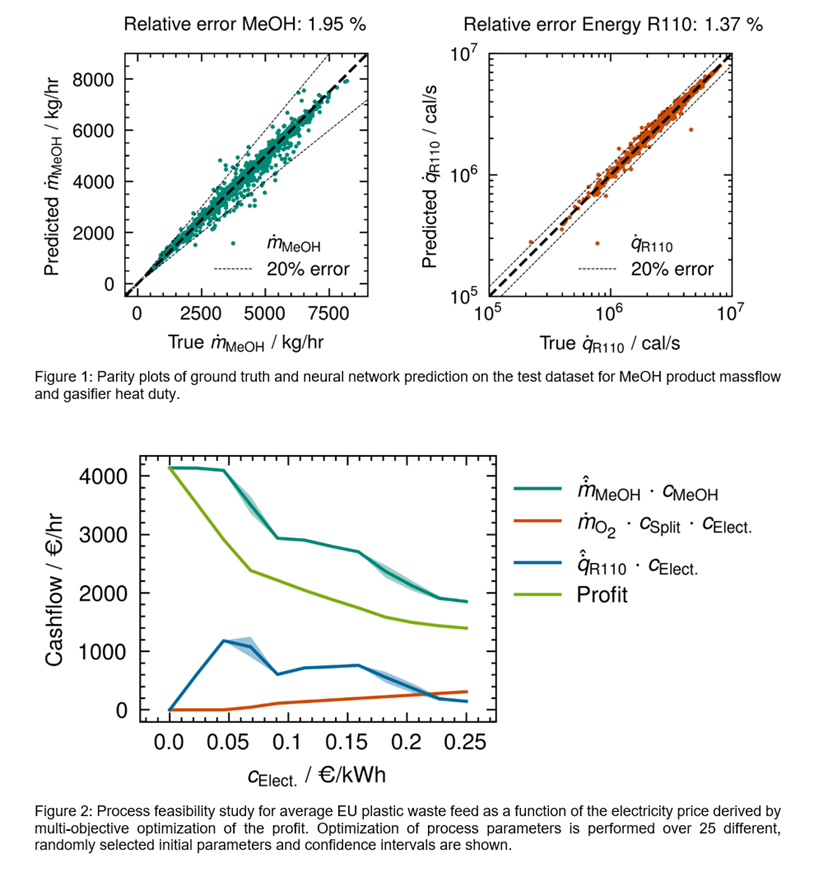With most of chemical industry having been designed around a linear value chain, the transition to a circular economy poses significant challenges: Recycling waste in feed streams results in fluctuations of feed compositions. The optimization and testing of processes with regard to their tolerance of these fluctuations are therefore of great importance to ensure resilience in the changing value chains.[1] Still, optimization by high-throughput flowsheet simulation is held back by significant computational cost. Neural network surrogate models have the potential to drastically reduce this cost.[2] Here, an automated high throughput flowsheet simulation was realized for a process describing plastic waste gasification and subsequent methanol synthesis. This simulation was used to generate data for training and testing neural networks as surrogate models for the complete flowsheet as a function of both feed compositions and process parameters. Then, the surrogate model is used for optimization of process parameters at a significantly reduced computational cost compared to the flowsheet simulation.
A candidate process for methanol production by plasma torch gasification of plastic waste was simulated using ASPEN Plus® V12.1 with varying feedstock compositions and process parameters. The flowsheet was constructed to be simple and rigid, with parameters typically set with design specifications chosen as parameters to be varied. Feedstock compositions were taken from an established elemental distribution of plastic waste[3] and the selected process parameters were randomly varied within selected bounds. The resulting methanol mass flows and gasifier heat duties were used as training targets in the dataset. A total of 20,000 data points were used to train and test the model. The simulations were run automatically using an Python routine with robust error handling. The dataset was used to train a feedforward neural network (FNN) implemented in the scientific computing Python library JAX. Gradient-based constrained optimization is utilized to maximize profits as a function of process parameters. The model was applied in a case study using the average EU plastic waste composition, aiming to demonstrate surrogate-based multi-objective optimization.
The trained FNN model achieves average relative errors of 2.0 % and 1.4 % for the methanol product stream and gasifier heat duty respectively, showing the ability to generalize based on the training data. A parity plot for the testing dataset is shown in Figure 1. In a next step, the surrogate models are used to optimize process parameters by gradient based optimization to maximize the process profit. The JAX library enables using automatic differentiation to calculate analytical gradients with little computational overhead. For the case study, a single optimization takes an average of 0.17 seconds on a consumer grade CPU while calling the neural network surrogate an average of 128 times. This means that the FNN model is at least three orders of magnitude faster than the flowsheet simulation. This low simulation cost enables high-throughput experimentation, allowing for optimization across a wide variety of scenarios, for example for a varying electricity price as shown in Figure 2.
Neural networks show great promise as surrogate models in process engineering due to their ability to handle multidimensional problems. The shown model achieves average relative errors of 2.0 % and 1.4 % with a dataset of 20,000 datapoints on a complex problem, indicating scalability for more extensive flowsheets. We demonstrate the ability to optimize for varying conditions, enabling increased process tolerance in fluctuating environments. The results of the case study show the potential of the model for process optimization, as it is at least three orders of magnitude faster than the original flowsheet simulation. The chemical industry stands to benefit greatly from the further development of AI surrogate models, which have the potential to significantly reduce the computational cost of simulations and digital twins while maintaining accuracy. This represents a major step towards Industry 4.0.
[1] A. Mitsos, N. Asprion, C. A. Floudas, M. Bortz, M. Baldea, D. Borvin, A. Caspari, P. Schäfer, Computers & Chemical Engineering 2018, 113, 209.
[2] M. Gärtler, V. Khaydarov, B. Klöpper, L. Urbas, Chemie Ingenieur Technik 2021, 93, 2063.
[3] M. Hungsberg, Distribution of European plastic waste composition, Technical University of Darmstadt, 2020.


